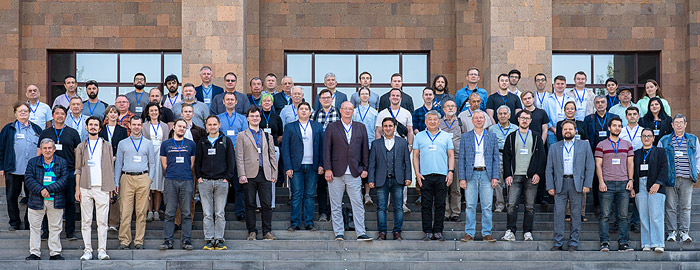
Electronic english version since 2022 |
The newspaper was founded in November 1957
| |
|
Number 40 (4788) |
Conferences
CHEP-Yerevan: to go on and to become better
From 29 September to 3 October, the International Conference on High Energy Physics CHEP-Yerevan-2025 was held in Yerevan, Armenia. The event was organized by Yerevan State University (YSU), the A.I.Alikhanyan National Science Laboratory (ANSL) and the Joint Institute for Nuclear Research. In addition to representatives from ANSL, the Conference Programme Committee included scientists from VBLHEP, DLNP, BLTP and from the scientific organizations from around the world. This is the second conference in this series; the first was held at ANSL in 2023.
Nearly 80 scientists from Armenia, Belarus, Germany, India, Iran, Mexico, Russia, the USA and Uzbekistan, as well as representatives of the international scientific organizations JINR and CERN participated in CHEP-Yerevan-2025. The Institute was represented by a large delegation of about 30 specialists from four laboratories: VBLHEP, DLNP, BLTP and MLIT. International experts gathered at YSU and ANSL to discuss the current state of research in high energy physics, including physics at the Large Hadron Collider (LHC), Higgs boson physics, high energy muon physics, physics beyond the Standard Model, hadron spectroscopy, heavy ion physics, spin physics, as well as advanced computational and analytical tools used in experiments at the LHC, SPS, NICA, KEK, CEBAF and other facilities.
Vice-Rector for Science at Yerevan State University Rafael Barkhudaryan opened the Conference. "It is a great honor for me to welcome all participants to Yerevan State University, a place with rich scientific traditions," Rafael Barkhudaryan said. "May your discussions be fruitful, your ideas inspiring and may your professional relations develop into strong scientific contacts. I hope that this conference will give new impetus to our shared efforts to expand the horizons of knowledge." In his comments, Rafael Barkhudaryan highlighted that YSU is committed to attracting young people to science and holding scientific conferences like CHEP-Yerevan-2025 can serve these goals, as well as enhance the university's visibility in the global scientific landscape.
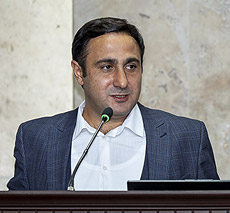 |
| Armen Tumasyan |
The participants were also welcomed by Chairman of the CHEP-Yerevan-2025 Organizing Committee, a leading researcher at the ANSL and Head of the Department of Nuclear Physics and Astrophysics at Yerevan State University Armen Tumasyan. "The ANSL in Armenia has a very strong position in physics at the Large Hadron Collider. We are largely successful in it thanks to the active support we obtain from the Dubna scientific community," Tumasyan emphasized in his commentary. He is also Head of the ANSL research team for the CMS experiment at the LHC.
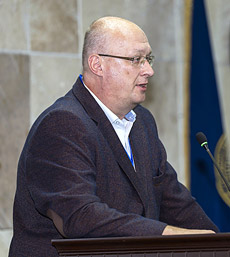 |
| Sergey Shmatov |
According to the organizers, the event is conceived as an international platform for scientists involved in obtaining and processing experimental data in high energy and particle physics to meet, to present their results and to discuss future research plans. "It includes both theoreticians and physicists that carry out the analysis, as well as specialists that design detectors, develop computational techniques, algorithms and develop computing systems that play a crucial role in processing experimental data," Sergey Shmatov emphasized. According to MLIT Director, of particular importance is the fact that CHEP-Yerevan-2025 discusses experiments and facilities that could be included in future international projects involving JINR, such as CEPC in China or SHiP at CERN.
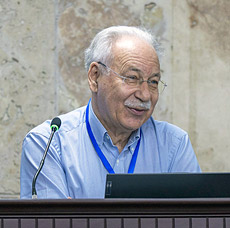 |
| Dmitry Kazakov |
In his report, D.I.Kazakov outlined a list of unresolved and open issues about the Standard Model of interactions that inevitably result in new physic and emphasized the diversity of approaches and research tools for searching for them. The traditional tools are particle accelerators, the largest of which, the Large Hadron Collider, whose annual news, unfortunately, does not provide any indication of new particles and interactions but rather only sets constraints on the parameters of the theoretical prototypes that predict them. The second subject of investigation at the LHC is the Standard Model and its precise testing. Here, various indications of deviations from theoretical expectations arise from time to time but they all eventually disappear. However, sometimes, events do occur that are not reducible to avoidable experimental errors, such as the recent observation of toponium - a bound state of top-antitop quarks on the verge of production. Beyond the LHC, news for the scientific community also comes from highly specialized accelerators operating at significantly lower energies, yet enabling precise investigations, for example, of the parameters of the Cabibbo-Kobayashi-Maskawa mixing matrix in the quark sector and the closely related issue of CP violation in the early Universe. Such experiments also allow for precise constraints on the rare decays of heavy mesons and baryons that may be influenced by new physics.
Another major research area is non-particle accelerator-based research: neutrino observatories, experiments searching for axions and anomalous magnetic moments of particles, others. Important constraints on the properties of neutrinos come from astrophysical experiments, particularly, those studying the anisotropy of the microwave background. The map of microwave background photons encodes a vast amount of information relating to the early Universe, the particles and the interactions that occurred then and this indirect technique can be used to obtain estimates of neutrino masses. Another source is the investigation of the accelerating expansion of the Universe using "standard candles" - Type Ia supernovae that provide both an estimate of the total density of the Universe and an upper estimate of the neutrino contribution. The issue of estimating the type (Dirac or Majorana) and source of neutrino masses, the hierarchy of neutrino masses of the three generations direct or inverse and the parameters of mass matrix mixing are among the aforementioned list of relevant unsolved issues. Here, great hopes are on the next generation of experiments with reactor, astrophysical and accelerator neutrinos, although a breakthrough in our knowledge on this issue will have to wait a little longer, as all of them are still in the preparatory stage.
News of experiments searching for gravitational waves has resonated with theorists and those generally engaged in the search for new physics. Although this field isn't directly related to high energy physics, like astrophysics, it is closely intertwined with it and holds great potential for answering the aforementioned large and complex questions, particularly, those related to the structure of the early Universe. It would be desirable for JINR physicists to participate more broadly and deeply in this endeavor, at least, in the European part of the joint LIGO-Virgo-KAGRA gravity project.
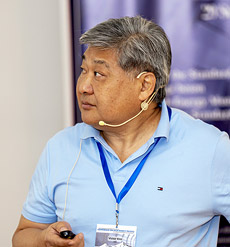 |
| Viktor Kim |
The theoretical focus of the Conference continued with a series of papers dedicated to items from the list of unsolved issues and challenges of the Standard Model. Discussions included the issue of dark matter and its description, the scale hierarchy problem, perturbation theory calculations and the inclusion of higher-order corrections that contribute to observability estimates and refine the accuracy criteria for new physics processes and a number of other topics. Viktor Kim (PNPI) presented his own perspective on calculating corrections to the Higgs boson mass and the associated criteria for the naturalness of the Standard Model. The topic of dark matter, the most mysterious object in the Universe, known only to exist, with numerous different theories proposing candidates for this role, but no fact or experimental result to support a preference for one theory was touched upon in two papers.
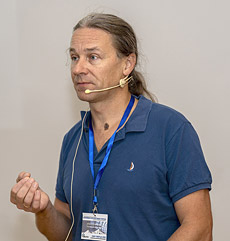 |
| Dmitry Gorbunov |
In a commentary on the report, it was highlighted that when it comes to dark matter, we know very little and it is not surprising. For starters, the history of particle physics as such is not very long, only about a hundred years old. Furthermore, the visible part of matter described by the Standard Model, that is, what we know represents less than 5% of the total composition of the components of the Universe that form its density. Therefore, it is not at all surprising that new physics could manifest itself in various forms and in a multitude of ways. "It was very interesting to discuss strong interactions under various kinematic conditions at this conference. And also, to compare my own estimates in various experiments with those of the specialists working on them. In terms of the effectiveness of the discussions, this conference was comparable to a very good workshop," Dmitry Gorbunov emphasized in his commentary. He highlighted the new and interesting results presented in the papers, such as the aforementioned observation of a bound state of toponium at the threshold of production, the occurrence of which was largely unexpected by the LHC collaborations, although it had been predicted by Russian theorists quite some time ago. He also emphasized the importance of obtaining results and interpreting them for rare processes that could harbor fascinating new physics.
In her talk, Maria Savina (BLTP) reviewed the situation with dark matter candidates in a slightly different mass range, weakly interacting massive particles (WIMPs). She presented a set of scenarios for the dark sector's structure that could be tested at the LHC.
Nonstandard physics can reveal itself both directly, through processes involving new particles and interactions, as well as indirectly, through the search for deviations from the Standard Model expectations. In the latter case, the highest possible accuracy in calculating standard processes using perturbation theory is of paramount importance. This topic always has a special resonance and at the conference, it was presented in talks on radiative corrections by BLTP staff members Ulyana Voznaya, Vladimir Zykunov and Leonid Kaptar. Petr Krachkov (BINP SB RAS) also presented a two-loop calculation of electron-positron annihilation with the production of a pair of heavy leptons.
In addition to new physics, the investigation of standard processes, but in unusual or extreme modes, is also of theoretical interest. In this vein, news on a well-known but still potentially surprising topic was presented by Misak Sargsyan (Florida International University, USA) in his talk on the spectral-functional approach to calculating hadron structure. The exchange of pomerons and photons for high-velocity p-A events at the LHC was the topic of a talk by Dmitry Sosnov (NRC Kurchatov Institute). Anatoly Egorov (PNPI) continued this topic with potential applications at future colliders in a talk on the results of investigations of high-velocity jet pairs for the search for new physics. Andrey Zelenov (NRC KI) discussed the role of diquarks in the production of large-pT hadrons in pp collisions.
Anna Dembitskaya (NRNU MEPhI) gave an interesting talk, not related to colliders but to the ideas and techniques of astrophysics. The possibility of chemical evolution in the early Universe and the persistent occurrence of an antimatter domain to this day was discussed in the report.
The experimental section of talks, dedicated to testing the Standard Model and searching for new physics beyond it, was extensive and diverse. This topic started by Sergey Shmatov's report that reviewed the latest results on the search for physics beyond the Standard Model in the CMS experiment at the LHC. Later, on different days of the conference, news from the LHC on Higgs physics, observations of Standard Model processes, the search for new Higgs states, the search for dark matter particles, processes forbidden in the Standard Model and others were covered. Soumya Mukherjee (University of California, San Diego, USA) presented a report on current measurements of the Higgs boson characteristics, Artur Apresyan (Fermilab, USA) spoke about the search for the process of pair production of Higgs bosons and the prospects for its observation at the LHC in the high-luminosity mode (HL-LHC), Alexey Raspereza (DESY, Germany) dedicated his report to the search for the heavy neutral Higgs boson, Yasaman Hosseini (Institute for Fundamental Research, Iran) presented results on the production of ttZ. The topic of the CMS experiment was continued in the reports of Alexander Lanev (VBLHEP) on the research of a pair of muons in the final state, Moytaba Mohammadi Najafabadi (Institute for Fundamental Research, Iran) on the search for neutral currents that change flavor in the decay of top quarks, Alexander Sedelnikov (MLIT) on the latest results in the physics of heavy quarks and Aram Hairapetyan (ANSL) on the search for long-lived particles.
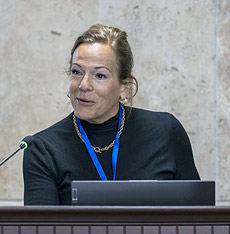 |
| Cynthia Keppel |
The future of the LHC, HL-LHC and of other potential projects that will continue to explore the fundamental properties of matter in 20, 30, and 50 years was discussed in a report by Yury Kulchitsky (DLNP) on the physics of the Higgs boson in the HL-LHC and CEPC experiments and the participation of JINR scientists in this work. The technical aspects of this issue were covered in reports by Vladimir Karzhavin (VBLHEP) on JINR's contribution to the modernization of the CMS experiment at the HL-LHC and Alexey Kamenev (VBLHEP) on the calibration of the gas amplification sensor.
The NICA megascience project is one of JINR's flagship experiments and its plans and prospects were discussed throughout the conference day. The discussion began on the opening day with a report by VBLHEP Acting Director Andrey Butenko that discussed NICA, the BM@N, MPD and SPD experiments, as well as the current status of the accelerator complex. He emphasized that to begin accumulating and processing real physical data, physicists need to prepare all the required data prototypes and the report aims to provide an understanding of the immediate area. According to Butenko, cooling of the collider's second semicircle will soon begin, cooling of the Nuclotron is ahead and the project team expects to obtain the first beams at the collider in December of this year. "Listening to the theoretical reports, it becomes clear in which area technological progress should move. The report on the Jefferson Laboratory, its research and its facilities was very interesting. "Conferences like these are crucial for cross-validation, where specialists in theory, experimentation and technology can meet for discussions and determine whether emerging ideas are feasible. It can be most effectively achieved at offsite events that allow participants to immerse themselves in the conference's work away from their daily work," Andrey Butenko emphasized.
On a separate day, a section dedicated to heavy ion physics featured a series of reports on experiments at the NICA accelerator complex. A chief researcher at VBLHEP and Head of the MPD collaboration Viktor Ryabov presented the current status and physics programme of the MPD experiment. VBLHEP scientists also presented reports on the status of the BM@N (Vasily Plotnikov) and SRC (Maria Patsyuk) experiments. Luis Alberto Hernandez Rosas (National Autonomous University of Mexico) discussed self-consistent efficient simulation of QCD matter under extreme conditions.
Alejandro Ayala (UNIAM), a representative of Mexico and Chairman of the Council of Institutions participating in the MPD collaboration, studies the properties of strongly interacting matter. At CHEP-Yerevan-2025, he presented a paper titled "Asymmetric µ+µ- emission in Z0 decays: A clean magnetometer in relativistic heavy-ion collisions". "This conference is interesting because it allows us to learn about the current state of research in various areas of high energy physics and to learn about cutting-edge experiments. I was very pleased to see a dynamic and active scientific community here. This is a fertile environment for both building scientific contacts and working with partners. For example, we are discussing with MLIT Director the possibility of establishing data transmission channels between Dubna and Mexico for processing MPD experiment data," Ayala said. He emphasized that cooperation between Mexico and JINR is in the active development stage and in addition to MPD, is aimed at joint research at the IBR-2 reactor and its spectrometer complex, as well as the dvelopment of an ion source in Mexico in collaboration with JINR specialists.
Also, in the heavy ion section, the following participants presented their reports: Khusnuddin Olimov (Physical and Technical Institute of the Academy of Sciences of Uzbekistan) - "Centrality and energy dependence of the kinetic parameters of freeze-out in high energy p+Pb, Xe+Xe and Pb+P-bolisms of the LHC", Amaresh Kumar Jaiswal (National Institute of Science Education and Research named after Jaiswal, Bhubaneswar) - "Spin polarization in collisions of relativistic heavy ions", Petr Parfenov (VBLHEP) - "Investigation of the possible measuring anisotropic fluxes in the fixed-target configuration of the MPD experiment", Mikhail Mamaev (VBLHEP) - "Directed proton flux in collisions of Xe+CsI at a beam energy of 3.8 A GeV with BM@N", Khachik Abrahamyan (VBLHEP) - "Observation of structures at energies of ~ 17 and ~ 38 MeV/c2 in the invariant mass spectra of γγ and e+e- in dCu collisions at a momentum of 3.8 GeV/c per nucleon."
MLIT staff members presented papers on advanced computational and analytical tools. MLIT Deputy Director Nikolay Voytishin discussed data processing techniques and algorithms in high energy physics. Danila Oleynik presented the software and computational design for the SPD experiment and Artem Petrosyan presented the control of a Monte Carlo simulation of the SPD experiment in a distributed environment. Alexander Airiyan discussed the use of machine learning for particle identification in the MPD and BM@N experiments.
Commenting on CHEP-Yerevan-2025, MLIT Director Sergey Shmatov also emphasized that participation in conferences of this caliber is an excellent opportunity for young scientists to showcase their research. "Here, young specialists have the opportunity to cooperate with senior colleagues and better define their research interests," Sergey Shmatov highlighted. He also stated that starting this year, the traditional internship for young Armenian scientists at JINR has been expanded. Currently, eight young physicists from JINR laboratories intern at the ANSL, actively participating in CHEP-Yerevan-2025 not only as speakers but also by assisting in organizing the conference. The internship participants presented a number of papers on topics related to the CMS experiment. Ivan Migunov spoke about measuring the production of the Higgs boson in the VBF process and its decay into bottom quarks in proton collisions at an energy of 13 TeV. Vladislav Shalaev (VBLHEP) reviewed the results of electroweak interaction emission at the LHC. Yury Korsakov presented approaches to searching for dark matter in invisible Higgs boson h125 decays. Kirill Slizhevsky discussed the production of dark matter particles in extended 2HDM prototypes. Ilya Zhizhin presented techniques for simulating events and backgrounds using Monte Carlo at the LHC. Dmitry Budkovsky presented a report on measuring the fraction of gluon jets in pp collisions at 13 TeV. Dmitry Kozlov presented the results of an investigation of the operation of cathode-strip chambers under high background conditions. Among the young scientists presenting from other scientific organizations was Aram Hayrapetyan (ANSL) that discussed the search for long-lived particles in the CMS. Artashes Chinaryan discussed multiparticle correlations in pp interactions at 13 TeV. Saveliy Omelyanchuk spoke on the topic of experiments at NICA, discussing a graph neural network with an attention mechanism for clustering particle tracks by events in the SPD experiment.
Commenting on the results, a leading researcher at the ANSL and a member of the JINR Scientific Council Armen Nersesyan said, "The Yerevan Conference on High Energy Physics was held for the second time but its level is clearly improving. It is confirmed by the fact that the number of participants in the hall did not decrease from the second day onward, as it often happens. The Conference hall was overflowing. I am confident that the Conference will go on developing and will only get better."
Within the framework of the Conference's social programme, CHEP-Yerevan-2025 participants took a tour of the Hovhannavank Monastery and the Church of St. Mesrop Mashtots on one of the days.
The next CHEP-Yerevan Conference on High Energy Physics is scheduled for 2027.
Source MLIT
